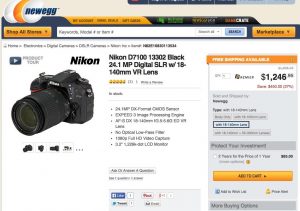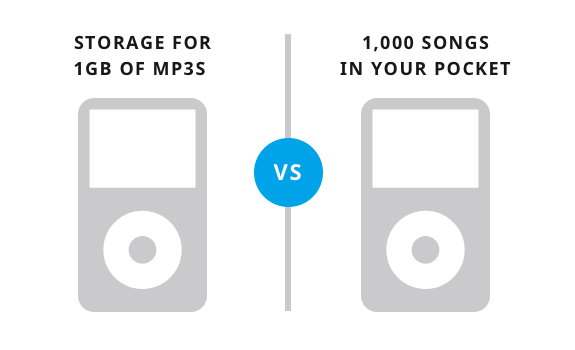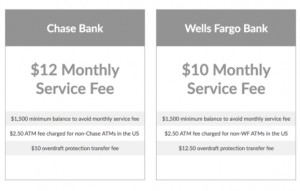
You want to show off your financial products, but how you do so makes a big difference. All marketing copy is not created equal, and there’s more to it than just making sure you avoid pesky grammar issues and spelling mistakes. In particular, the copy on your credit union site has a big impact on your public perception. Your website is the face of your credit union. You need stellar copy there that reflects the true value your credit union has to offer.
What’s the best way to talk about the value you offer? In this post, we’ll discuss the difference between features, advantages, and benefits. First, we’ll break down what we mean by each of these terms. Then we’ll explain why benefits are superior to features and advantages when it comes to writing copy that converts.
What are features?
Features are facts and figures. They are pieces of specific, objective information about your product.
Example: “Our Money Market account earns a 0.5% dividend.”
Here’s an image of product page that only includes features:

Source: Baymard
If you look at the bullets in the middle of the page, you can see that they are simple, straightforward facts about the product.
On the financial side, let’s take a look at these two images as well:
Source: CUInsight
These discuss various fees for two different bank accounts, with no commentary or additional information. On their own, these are just features.
Why use features?
Features are not a bad thing. In fact, they are important. Your members and potentials members will be looking for specific information. Some credit union sites do not include any details at all about their different products and services, and expect people to show interest regardless. They might believe that simply saying they have a certain type of account will be enough for people. That’s not true, and giving your audience information about your product is essential. However, features are also only the bare minimum when it comes to copy. You can make your writing far more compelling by going beyond them.
What are advantages?
Advantages are comparisons. Advantages compare products, but do not specifically solve a problem for the end user. The most common example of an advantage is pointing out how one of your features is better than one of your competitor’s features.
Example: “Our Money Market dividends are 20% higher than banks in our area.”
Why use advantages?
Advantages help set you apart. They are often more compelling than features alone, because they are more positively worded. On their own, your dividend rates might not mean much to someone, but if you show your rates are higher than your competitor’s, there’s greater appeal. However, improving your copy doesn’t stop with advantages. There’s a third strategy available to you, one with even greater rewards.
What are benefits?
Benefits show specifically what your product can do for your audience. They solve a problem your audience already has.
Example: “Our Money Market accounts help you grow your money.”
Consider this simple graphic:

Source: Wordstream
As you can see, the features show what the umbrella is made of. On the other hand, the benefits show what the umbrella will do for the buyer: it will protect them from the sun and rain.
This graphic shows another great example of selling benefits:

Source: HelpScout
We like this example even better because it gets a little more personal. Those 1,000 songs are going into your pocket. With just a sentence, potential users can see how an iPod will benefit them.
Why use benefits?
Let’s go back to our example of the Money Market account: “Our Money Market accounts help you grow your money.” In this case, the benefit is “grow your money”.
Growing money is one of the principle reasons your audience would be interested in a Money Market account in the first place. They want to hear that benefit said back to them, so they know they are getting what they are looking for.
There are numerous studies that have found that selling benefits increases conversions. We were particularly impressed with the research GoodUI.org has done. In the below table, they summarized several tests that proved the usefulness of benefits:
This set of tests also supported using benefits, and noted that they tend to convert even better when they are put into bullets:
Depending on your copy, bullets may not always be possible, but it’s something you should consider.
We should note that all of this doesn’t mean you should abandon features or advantages. Again, advantages help set you apart from your competitors, which is important. Features prove that you really have the benefits you are offering. They are your way of “walking the walk”.
Benefits are irreplaceable because they help people understand the ultimate purpose of a product. As we talked about, a Money Market Account helps members “grow money.”
But now, the audience may want to know which bank will help them grow their money fastest. Hence, the advantage “grow money 20% faster,” becomes important.
Then, features back up advantages and benefits with facts: “grow your money 20% faster with a dividend rate of 0.5%.” When you combine benefits, advantages, and features, but put the primary emphasis on benefits, you get persuasive copy.
How to write benefit-driven copy
To write copy that truly shows off the benefits, you need to get as much data on your audience as possible. Only then can you know which problems they want to solve. As a designer for credit union sites, one of the first things we ask our clients for is information on their potential membership base. We want a complete picture of the people we are trying to connect with.
However, since credit unions cover wide demographics, you should also write your benefits according to general human needs. You may have heard of Abraham Maslow’s theory of human motivation, which groups human needs into five specific categories:
- Physiological Needs (such as food, water, and shelter)
- Safety Needs (such as good health, and personal and financial security)
- Social Belonging Needs (such as family and friendships)
- Esteem Needs (such as high self-esteem, confidence, and independence)
- Self-Actualization Needs (the ability to reach one’s full potential)
Tapping into any of these needs in your writing strikes a strong chord with your audience, and lets you truly highlight benefits. Let’s say you are discussing the benefits of a home loan. You might write “Enjoy a home that’s all yours” (Esteem Needs) or “Give your family a place they can truly call home” (Social Belonging Needs).
You can even hit more than one need at a time, with a sentence like this “Owning your own home will bring you and your family confidence, independence, and a sense of belonging.” This point highlights both esteem and social belonging.
Conclusion
If you’re not accustomed to writing this kind of copy, it may take a little practice. Writing well-thought-out benefits, and pairing them with features and advantages, takes time. You may be shocked to find yourself taking an hour to put together just a few bullet points on your home page. However, as you can see from the data above, the payoff will be well worth it.
Want more insights?
Get our crazy ideas and doable tips in your inbox.




